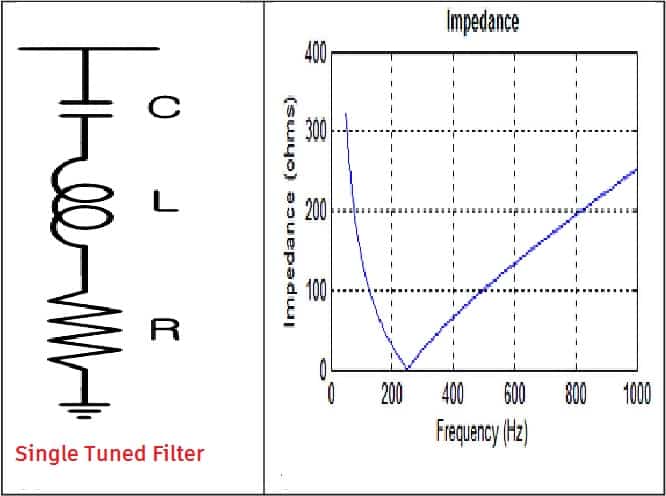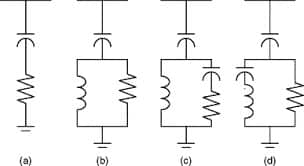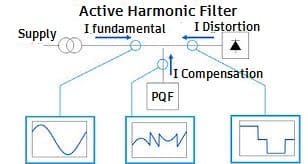Harmonic filter selection is essential because all orders of harmonics harm an electrical power system, with the 5th and 7th harmonics being especially damaging to electrical networks. One solution to mitigate these lower-order harmonics is to install harmonic filters.
These filters help eliminate power quality issues like voltage distortion, equipment overheating, and potential resonance in harmonic filter circuits.
Harmonic filters are essential components in power quality improvement, especially for harmonics filtering in sensitive industrial and commercial applications. Whether it’s active, passive, or hybrid harmonic filters, each type is selected based on the system’s harmonic spectrum, load profile, and resonance risk.
We will discuss the criteria for harmonic filter selection in detail.
Types of Harmonic Filters in Power Systems
The harmonic filters can be categorized into three categories, i.e., passive filters, active filters, and hybrid filters. The passive filter has passive components like a resistor, inductor, and capacitor. The active filter is designed using semiconductor devices like IGBTs.
Hybrid harmonic filters are increasingly popular for their efficiency in filtering both low-order and high-order harmonics across varying load conditions.
Hybrid filters are a combination of active and passive filters. For the cost-effectiveness of the installation, the hybrid filters are used to mitigate the lower-order harmonics using the passive filters and the higher-order harmonics using the active filters. A combination of active and passive filters is known as a hybrid filter.
Understanding Passive Harmonic Filters: Tuned vs De-Tuned
The passive filters can be further categorized into tuned and de-tuned filters. The frequency of the 5th and 7th-order harmonics is 250 Hz and 350 Hz, respectively. The passive filters are generally used to mitigate 5th and 7th-order harmonics because the magnitude of lower-order harmonics’ current is greater than that of higher-order harmonics.
In power systems where specific harmonic orders dominate, tuned or de-tuned passive filters are a practical and economical choice.
Tuned Harmonic Filter Selection and Resonance Risk
A tuned filter works on the principle of providing the least impedance path for one or two harmonic frequencies and has a tuning frequency that is within +/- 10 % of the harmonic frequency to be filtered. Tuned filters of particular harmonics order carry more harmonic current as they offer low impedance to the dominant harmonics.
Therefore, the tuned filter design has to be done carefully. The tuned filter is formed with a combination of inductance and capacitance, so they are bulkier than the de-tuned and active filters.
The tuned filters can be installed only after a detailed harmonics study. Inherently, tuned filters do not adapt quickly to changes in power network configuration, and their efficiency is usually altered when network configuration changes.
While effective, tuned filters must be carefully deployed to avoid resonance in harmonic filters, especially when inductive and capacitive reactances are equal.

Whenever new non-linear loads get added to the network after the installation of the filters, harmonics studies are again required to be carried out. Several tuned filters are to be used in parallel if more than one harmonic frequency is to be filtered. The self-resonance frequency is related to the tuning factor, which is defined as the ratio of the inductive to capacitive reactance of the filter expressed as a percentage.
This resonance condition can result in excessive voltage distortion and lead to capacitor failure or equipment malfunction.
The major problem with tuned filters is that if the inductive reactance of the electrical network is equal to the capacitive reactance of the system, the resonance phenomenon occurs. The resonance phenomenon can cause the failure of the power factor correcting capacitors.
De-tuned Harmonic Filter Selection for Safe Operation
To solve this resonance issue, the filter is deliberately tuned for a particular harmonic frequency. For example, the filter for 5th-order harmonics current is designed for a frequency lower than 250 Hz. With detuning, some percentage of the harmonics current remains unfiltered, but the resonance can be avoided.
De-tuned harmonic filters provide a robust solution for avoiding resonance while still effectively reducing lower-order harmonics.

Tuning Factor and De-Tuning Formulas
The tuning factor can be given to the tuned filters to avoid the resonance problem. The following mathematical expressions give the tuning factor and tuning frequency of the harmonic filter:
Tuning factor, p (%)
=[(Inductive reactance) / ((Capacitive reactance)] x 100
= (XL/XC )*100
Tuning frequency of the filter,
Fr=Fs/√0.01p Hz (P is in percentage)
For 5 % detuning Fr=50/√ 0.05 = 224 Hz
Where fs = Fundamental system frequency
Adjusting the tuning factor allows engineers to shift the filter’s response away from system resonance conditions.
Filter frequency with de-tuning
| De-tuning Factor (%) | Filter Frequency (Hz) |
| 5 | 224 |
| 7 | 189 |
| 8 | 177 |
| 14 | 134 |
Active Harmonic Filter – Advanced Harmonic Filtering Technology
The PWM INVERTER technology is the basic building block of an Active Harmonic Filter. Active filters are new-generation harmonic filters that use modern technologies and devices to provide revolutionary filtering solutions.
The active filter produces the harmonic currents spectrum in phase opposition to that produced by the non-linear loads, and these generated harmonic currents of the active filters are injected into the system in real time to ensure the effective cancellation of all harmonics present in the network.

Active harmonic filters are ideal for dynamic loads, where harmonic spectrum and load profile change frequently.
In addition to canceling the harmonic current, an active filter also improves the power factor by providing both capacitive and inductive reactive power in a step-less manner. Active filters are the most technologically advanced solutions available for harmonic filtering.
The active filter uses a CPU to detect the order and magnitude of the harmonics present in the network. It generates a harmonic current spectrum in phase opposition to the measured spectrum.
Conclusion: Choose the Right Filter for Harmonic Control
Selecting the correct harmonic filter depends on the harmonic order, cost, system flexibility, and future load expansions.
- Passive filters are reliable for fixed harmonic frequencies like 5th and 7th orders.
- Tuned filters offer low impedance but pose a risk of resonance in harmonic filters.
- De-tuned filters mitigate this resonance risk while sacrificing some filtering performance.
- Hybrid harmonic filters combine the best of both active and passive technologies, offering cost-effective and adaptive harmonic suppression.
- Active filters are ideal where the load profile frequently changes or where space and precision are critical.
Effective harmonics filtering is key to enhancing system efficiency, reducing losses, and maintaining grid code compliance.
Related Articles:
Informative article